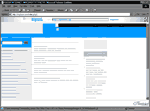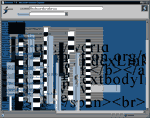|
Best Viewed Without a Browser
Aaron S. Lav believes that the best way to read HTML documents is
without a browser: users should connect to the appropriate port,
and then display the raw HTML at 30, 120, or 240 characters per
second. At such speeds, subtle nuances of pacing can be appreciated;
with traditional all-at-once rendering, such nuances are thrown
away. Also, semantically different tags, such as "<cite>"
and "<em>" are easily distinguished without an interfering
browser to render them both as italic. Lav deplores the fact that
few designers today care about such nuances and he therefore wants
everybody to join the "Best Viewed Without a Browser"
campaign today and make their voices heard! (Um, figuratively speaking.)
Aaron S. Lav is the author of music software such as Dissociated
Studio and RhythmLab. He also conducts research at the Center for
Feline Excellence in Chicago, where he resides with his two cats.
http://www.enteract.com/~asl2/bvwb/
Browser Gestures
 Browser
Gestures is an ongoing series of applications that reinterpret what
a browser is. It represents the network outside of the well-accepted
page metaphor. The three already existing browser models - Blur
Browser (pages are blurred), History Browser (pages are layered)
and Icon Browser (pages are tiled) - reinterpret how browsers normally
display and navigate information for the user. In some cases, the
browser abstracts the information that is to be displayed by sending
the requested page through a feedback loop. In other cases, the
browser takes the form of a browser's "history": the user
must sift through layers of previous pages that have accrued since
the browser was opened. Browser
Gestures is an ongoing series of applications that reinterpret what
a browser is. It represents the network outside of the well-accepted
page metaphor. The three already existing browser models - Blur
Browser (pages are blurred), History Browser (pages are layered)
and Icon Browser (pages are tiled) - reinterpret how browsers normally
display and navigate information for the user. In some cases, the
browser abstracts the information that is to be displayed by sending
the requested page through a feedback loop. In other cases, the
browser takes the form of a browser's "history": the user
must sift through layers of previous pages that have accrued since
the browser was opened.
Browser Gestures is a project by web artist Mark Daggert.
http://www.flavoredthunder.com/dev/browser-gestures/
The Grid
Turn off your computer: This network of browser interface studies
and interactive trinkets accepts the spectator's gesture as part
of the artistic moment. Mouse movements within The Grid are converted
to data adjustments where user kinetic energy charges the work.
Every click and roll creates a presence and feeds the power matrix
of action and responses. Real power is illusory, though, as interaction
doesn't necessarily mean everyone gets a seat at the desktop. The
action/response network within this work is a personal attempt to
simulate creative exchange, but retain artistic authority in an
increasingly interactive world.
Brian Judy is an artist and programmer. He has a Masters of Fine
Arts degree from The School of the Art Institute of Chicago. Currently
he works as an independent developer of Internet projects.
http://www.boogaholler.com/webart/
Internet Implorer
 Internet
implorer is a work of the German web artist group Rolux.org. The
application implores Internet web pages in a very, very white way.
The Implorer gradually empties web sites by replacing all texts
and images with blank fields, thus wiping out the whole content.
On an aesthetical basis, especially commercial web space really
looks great. The Berlin based group's other web projects can be
accessed at http://www.rolux.org. Internet
implorer is a work of the German web artist group Rolux.org. The
application implores Internet web pages in a very, very white way.
The Implorer gradually empties web sites by replacing all texts
and images with blank fields, thus wiping out the whole content.
On an aesthetical basis, especially commercial web space really
looks great. The Berlin based group's other web projects can be
accessed at http://www.rolux.org.
http://implorer.com/index.php3
Netomat
Netomat eschews the anachronistic page structure of today's web
by not privileging layout and design. It atomizes text, image and
audio by loosening them from web sites and web pages. This allows
the data to be recombined or viewed independently in a context determined
by the user. Netomat, presented in 1999 as one of the first non-linear
browsing experiences, dynamically spawns multiple browser interfaces
and functionality created openly and by many. This project relies
on an active and distributed use by communities of internet users
since it attempts to engage the internet differently, much like
the way it was originally intended and further than currently envisioned.
The creators of Netomat perceive the web not only as a database
or a static, flat file-storage system, but as one big application.
Netomat is a project of Maciej Wisniewski of the New York based
collective/company Netomat. Netomat was presented at the first New
York Browserday.
http://www.netomat.net/orig.html
Pornolize
Pornolize deals with such issues as introducing fistfucking or anal
intercourse into public web contents - and generally the DirkDigglerization
of modern life. You enter the URL of your least favorite web site
and then stare disbelievingly at its 'perverted' content. Nothing
more to say.
Is it one more debate in the net-porn-discourse or just a tool that
is … err … cool? Decide for yourself. And don't forget
to "fuck the pain away" (Peaches).
Pornolize is a project of JUNIKS (http://www.juniks.org/)
http://www.pornolize.com
Riot
Riot is a self-defined "cross-content browser". Since
PR people like to say that on the web "content is king",
Riot, released in 2000, tries to depose that king by uprooting images
and text from separate web pages and throwing them together into
one raucous collage. Posing as a normal browser, Riot dissolves
the territorial boundaries on the web. Once in "Riot",
your browser will behave much as it normally does. You may surf
by entering a URL into the location bar, or choose a recent page
from the history list, or choose one from your list of bookmarks.
Nevertheless - the web will change - from slightly to radically.
Riot is a project of NY-based Artist Mark Napier. Mark Napier has
most recently drawn attention to his work with a series of pictures
of "Distorted Barbies" that he placed on his web site
and the following Matell lawsuit.
http://www.potatoland.org/riot/
Shredder
 The
web browser as an organ of perception through which we 'see' the
web filters and organizes a huge mass of structured information
that spans continents. It is constantly growing, reorganizing itself,
shifting its appearance, and evolving. As long as all browsers more
or less agree on the conventions of HTML, there is the illusion
of solidity or permanence in the web. The Shredder, first released
1998, was one of the first applications to present this global structure
as a chaotic, irrational, raucous collage. By altering the HTML
code before the browser reads it, the Shredder appropriates the
data of the web, transforming them into a parallel web. Thus content
becomes abstraction. Text becomes graphics. Information becomes
art. The
web browser as an organ of perception through which we 'see' the
web filters and organizes a huge mass of structured information
that spans continents. It is constantly growing, reorganizing itself,
shifting its appearance, and evolving. As long as all browsers more
or less agree on the conventions of HTML, there is the illusion
of solidity or permanence in the web. The Shredder, first released
1998, was one of the first applications to present this global structure
as a chaotic, irrational, raucous collage. By altering the HTML
code before the browser reads it, the Shredder appropriates the
data of the web, transforming them into a parallel web. Thus content
becomes abstraction. Text becomes graphics. Information becomes
art.
Shredder is another project of NY-based Artist Mark Napier.
http://www.potatoland.org/shredder/
%WRONG Browser
Jodi.Org tries out different looks of the browser screen display
and the syntax of the URL, because they like to demonstrate that
the "wrong" browser is stronger than the "real"
browser. The browser was the first program equipped with the "View
source"-function, so you could look beneath the screen surface
and perceive and read the code layer. It dates from a time when
the web was struggling for popularity and the first Mosaic browser
spread an "How-to-do-this" button with every page.html.
Jodi focuses on this layer underneath. All three of the "Wrong
Browsers" (2000) don't really look like an "internet experience"
anymore. Jodi states that this is the case because users are conditioned
by the "real" browser. "Users" are "used"
to watching "comets-falling-over-the-small-upper-right-corporate-Logo",
and looking at "the-lower-left-side-of-you-frame" to read
and believe they are %Connected and %Downloading.
Jodi.Org works on the deconstruction of the net since 1994.
http://www.wrongbrowser.com
|

